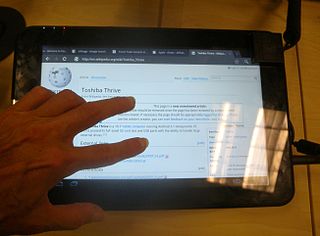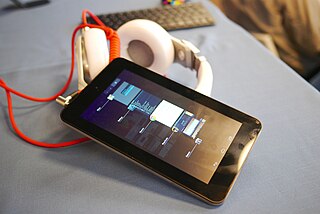Archos is a French multinational electronics company that was established in 1988 by Henri Crohas. Archos manufactures tablets, smartphones, portable media players and portable data storage devices. The name is an anagram of Crohas' last name. Also, in Greek (-αρχος), it's a suffix used in nouns indicating a person with power. The company's slogan has been updated from "Think Smaller" to "On The Go", and the current "Entertainment your way".

A tablet computer, commonly shortened to tablet, is a mobile device, typically with a mobile operating system and touchscreen display processing circuitry, and a rechargeable battery in a single, thin and flat package. Tablets, being computers, have similar capabilities, but lack some input/output (I/O) abilities that others have. Modern tablets largely resemble modern smartphones, the only differences being that tablets are relatively larger than smartphones, with screens 7 inches (18 cm) or larger, measured diagonally, and may not support access to a cellular network. Unlike laptops, tablets usually run mobile operating systems, alongside smartphones.

The Portégé is a range of business-oriented subnotebooks and ultrabooks manufactured by Dynabook Inc. From 1993 to 2016, the Portégé was manufactured by Toshiba's computer subsidiary. The Portégé series was briefly discontinued after Toshiba left the computer market in 2016. In 2019, Sharp Corporation purchased majority interest of Toshiba inactive's computer subsidiary and resurrected the Portégé.

Ingenic Semiconductor is a Chinese fabless semiconductor company based in Beijing, China founded in 2005. They purchased licenses for the MIPS architecture instruction sets in 2009 and design CPU-microarchitectures based on them. They also design system on a chip products including their CPUs and licensed semiconductor intellectual property blocks from third parties, such as Vivante Corporation, commission the fabrication of integrated circuits at semiconductor fabrication plants and sell them.
This is a list of tablet computers, grouped by intended audience and form factor.

A smartbook was a class of mobile device that combined certain features of both a smartphone and netbook computer, produced between 2009 and 2010. Smartbooks were advertised with features such as always on, all-day battery life, 3G, or Wi-Fi connectivity and GPS in a laptop or tablet-style body with a screen size of 5 to 10 inches and a physical or soft touchscreen keyboard.

A dual-touchscreen is a computer or phone display setup which uses two screens, either or both of which could be touch-capable, to display both elements of the computer's graphical user interface and virtualized implementations of common input devices, including virtual keyboards. Usually, in a dual-touchscreen computer or computing device, the most persistent GUI elements and functions are displayed on one, hand-accessible touchscreen alongside the virtual keyboard, while the other, more optically-centric display is used for those user interface elements which are either less or never accessed by user-generated behaviors.
The Dell Venue is a line of Android smartphones and tablets manufactured by Dell. The first Dell Venue was released for both T-Mobile and AT&T in the United States, and for KT in South Korea. It was the second Dell smartphone to be released in the US and features the Dell Stage UI also found on the Dell Streak line of tablets. As of 2011, it was the only Android device the United States Department of Defense has approved for its employees use. Since then, there have been other approved devices.

The Asus Eee Pad Transformer TF101 is a 2-in-1 detachable tablet developed by Asus that runs the Android operating system. It is the first tablet in the Asus Transformer Pad series. The Eee Pad Transformer features a 10.1-inch (260 mm) display, an Nvidia Tegra 2 dual-core chip, 1 GB of RAM, and 16 or 32 GB of storage. The tablet initially launched with Android 3.1, nicknamed "Honeycomb", but was updated to support Android 4.0.3.

The Toshiba Thrive was a 10.1" tablet computer running Android 3.2.1. PC World praised its full-sized and versatile SD card slot, HDMI port, and USB ports with host functionality and the ability to handle large external drives as well as standard peripherals like USB Keyboards, printers and cameras. The review concluded that there were minor disadvantages including a bulky form and poor sound quality. CNET's review said "Its grooved back, full HDMI and USB support, full SD card slot, and replaceable battery justify its very bulky design."

Xperia Tablet, formerly known as Sony Tablet, is the brand name of a series of tablet computers. The first models originally ran Google's operating system Android 3.1 Honeycomb, but more recent models operate on the Android 4.1.2 system. The first models were informally announced on 26 April 2011, using the code names, by the Sony Corporation in the Sony IT Mobile Meeting. They featured touchscreens, two cameras, infrared sensor, Wi-Fi. Also, they support PlayStation Suite, DLNA, and are 3G/4G compatible. The retail price in the U.S at the time of release was US$499–599. In Europe, prices were at €499. To increase the number of apps available and provide marketing support for both tablets, Sony and Adobe Systems will hold a $200,000 competition targeting app developers. The series was formally launched in Berlin and Tokyo on 31 August 2011. The latest in the series is the Xperia Z4 Tablet.

The Acer Iconia is a range of tablet computers from Acer Inc. of Taiwan.
The Samsung Galaxy Tab 7.7 it was a tablet computer of a series of Android-based tablet computer produced by Samsung, introduced on 1 September 2011 at IFA in Berlin. Related models are the Galaxy Tab 7.0 Plus, Samsung Galaxy Tab 2 7.0, and Samsung Galaxy Tab 3 7.0.

The Amazon Fire, formerly called the Kindle Fire, is a line of tablet computers developed by Amazon. Built with Quanta Computer, the Kindle Fire was first released in November 2011, featuring a color 7-inch multi-touch display with IPS technology and running on Fire OS, an Android-based operating system. The Kindle Fire HD followed in September 2012, and the Kindle Fire HDX in September 2013. In September 2014, when the fourth generation was introduced, the name "Kindle" was dropped. In later generations, the Fire tablet is also able to convert into a Smart speaker turning on the "Show Mode" options, which the primary interaction will be by voice command through Alexa.

The Tablet S is the first modern tablet computer released by Sony. Featuring a "unique asymmetric design", the Tablet S runs Google's Android 3.2 Honeycomb operating system and features a 9.4 in (240 mm) multitouch display, 1 GHz Nvidia Tegra 2 dual core processor, Wi-Fi ability, front- and rear-facing cameras, Bluetooth, and an infrared sensor. It is also configured with access to the Sony Entertainment Network and is PlayStation Certified and Digital Living Network Alliance (DLNA) compatible. Tablet S was first released in September 2011. It was succeeded by the Xperia Tablet S, which would be created by Sony's new subsidiary Sony Mobile.
The IdeaPad tablets from Lenovo were a brand of consumer-oriented tablet computers designed for home use or entertainment, as opposed to the business-focused ThinkPad Tablet series. Devices sold in certain countries, such as China, India and New Zealand, were sold under the LePad brand, similar to the LePhone series of smartphones. IdeaPad-branded tablets have been produced with the Android and Windows operating systems.

The Nvidia Shield Portable is a handheld game console developed by Nvidia, released on July 31, 2013. The console runs on Android Lollipop 5.1, featuring a flip 130mm (5-inch) touchscreen display with 1280×720 resolution. The device is similar in shape to an Xbox 360 controller and similar in control setup to a DualShock controller, with two analog joysticks, a D-pad, and other buttons. It is the first device to use Nvidia's Tegra 4 processor. It was originally called Shield or Nvidia Shield, but since the launch of the Shield Tablet, it is called the Shield Portable. Due to being out of stock for many years, it is thought to be discontinued, but there has not yet been any official announcement from Nvidia.

The HP Slate 7 is a 7-inch Android 4.1 tablet that was announced on February 24, 2013 and started shipping in April 2013. It has a stainless-steel frame, black front, and gray or red soft-touch back. A key feature of this small tablet is the microSDHC slot. It is HP's second Android device.

The second-generation Nexus 7, also commonly referred to as the Nexus 7 (2013), is a mini tablet computer co-developed by Google and Asus that runs the Android operating system. It is the second of three tablets in the Google Nexus tablet series, the Nexus family including both phones and tablets running essentially stock Android which were originally marketed for developer testing but later marketed by Google to consumers as well, all of which were built by various original equipment manufacturer partners. Following the success of the original Nexus 7, this second generation of the device was released on July 26, 2013, four days earlier than the originally scheduled date due to early releases from various retailers. The tablet was the first device to ship with Android 4.3.











